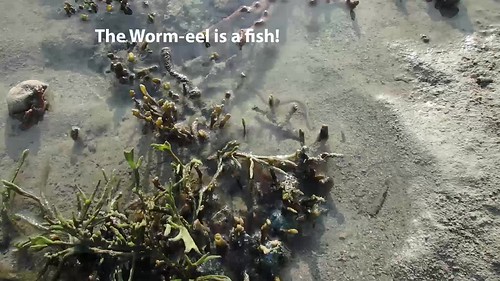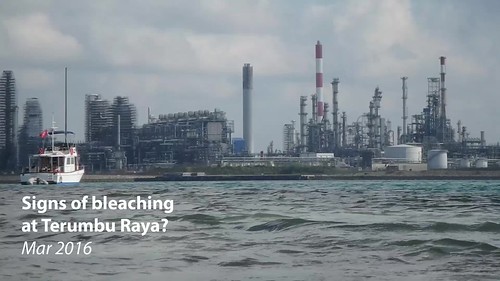Alas, the seagrasses are not doing very well. But the shore remains lively with interesting encounters.
This submerged reef lies near the petrochemical plants on Pulau Bukom.
This submerged reef lies opposite Pulau Hantu and the petrochemical plants on Pulau Bukom, and is next to Pulau Semakau.
This little Pink-speckled shrimp-goby zoomed out of its burrow and settled next to my bootie! As its name suggested, the shrimp goby lives in the same burrow with a snapping shrimp. With keener eyesight, the goby keeps a look-out while the shrimp busily digs out and maintains their shared home. The shrimp is literally constantly in touch with the goby with at least one of its antennae always on the goby. When the goby darts into the burrow, the shrimp is right behind it!
Another interesting little fish that is commonly seen on our reefs is the Worm eel. Which is perfectly shaped for checking out crevices and burrows on the reef.
I can only spot large nudibranchs like this Discodoris boholiensis that is often mistaken as coral rubble.
It has been very hot lately, which makes us worry about coral bleaching. So we also checked for this during our trip. Here's the latest Bleaching Alert Areas from the NOAA website. Singapore appears to be outside the 'Watch' status. What is coral bleaching and why this is of concern on the Bleach Watch Singapore blog.
The reef flat is dotted with many large boulder shaped Merulinid corals (previously called Favid corals). Most of those I saw were not bleaching.
But I saw some corals turning pale of having odd colours. But only very few colonies were actually bleaching and most were only partially bleaching.
Some of the large Pore corals were pale on top but not bleaching.
Many of the Cauliflower corals I saw were very pale at the tips. These corals were among the first to bleach in 2010. But all the Sandpaper corals I saw were mostly still dark brown.
I saw a few colonies of Merulinid corals that were pastel coloured and a few that were partially bleaching. Also a bright green Pebble coral. I saw a few Brain corals that were pale, and the few Flowery disk corals I saw were also pale and yellowish.
I also saw a few bleaching corallimorphs, and many of the Sea mat zoanthids I saw were pale. But the other kinds of zoanthids I saw were alright. There were abundant patches of Brown feathery soft corals that seemed alright.
The Pizza anemone is usually well camouflaged. Does the bright colours of this one mean that it is about to bleach? Nick and I also looked for Frilly anemones and many of those we saw were pale and yellowish. We did come across a Giant carpet anemone with anemonefishes and Haddon's carpet anemone that were alright. The tide wasn't low enough to look for the Bubble-tip anemones that were usually found on the reef edge, which we saw on our trip in Jun 2015.
The seagrasses here don't appear to be doing well. Although I did come across some long Tape seagrass, most of the Spoon seagrasses were covered in epiphytes. There were also cropped or burnt Sickle seagrass.
We are sad that none of us saw the Fluted giant clams that we saw on our trip in Jun 2015.
There is a faint trace of smoke from the petrochemical plants at Pulau Bukom. I got another update today from Shell which said that the issues that resulted in "flaring with intermittent dark smoke" yesterday has been resolved. It's good to know that they are reaching out to the marine community about such issues.
Photos shared by others on the trip
- Russel on facebook.
- Jonathan Tan on facebook.
- Marcus Ng on facebook.
- Richard Kuah on facebook.
- Juria Toramae on facebook.















